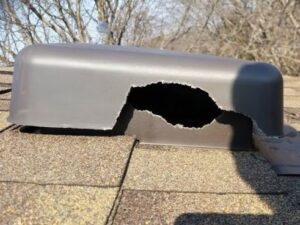Attic Ventilation
We are roofers with experience and knowledge dedicated to provide the best solutions to our valued customers.
Proper attic ventilation is crucial for a healthy home. When installed correctly, roof vents prevent condensation and help to increase your roof’s lifespan.
As every home is different, the number of intake and exhaust vents required to provide proper roofing ventilation will change accordantly. A roofing expert will be able to assess your roof and make the right recommendation.
Advantages of proper attic ventilation
- Prevents moisture buildup in your attic. Excess moisture minimizes the lifespan you’re your roof’s structure; it can affect your insulation and cause mould and rot.
- Improves your roof’s durability. It eliminates extreme temperature ranges and protects the lifespan of your shingles.
- Helps you save on energy bills. Roof vents help to moderate the temperatures in the attic and therefore moderates the temperature inside your home.
- Minimizes ice damming
When choosing your roofing contractor to install your roofing vents, be sure to hire an expert. More attic ventilation doesn’t always mean better. You need a balanced system with the right amount of exhaust and intake vents according to your home’s size.
The intake vents are usually located near the soffits; they came as two options: continuous soffit vents or single soffit vents. Their purpose is to allow outside air into your attic. The exhaust vents do the opposite; they allow air in the attics to exit and are usually located near a roof assembly’s ridge or high point.
Different types of attic ventilation
Intake Roof Vents
Soffit Vented: Soffit vents are one of the most popular styles in the industry; they come in two options: continuous soffit vents or single soffit vents. The vents are usually made of aluminum or vinyl and are installed on the surface under the roof’s eave, known as the soffit.
Edge Vents: If your roof style doesn’t allow soffit vents you should consider using edge vents. They are installed at the edge of the roof; edge vents direct the water away from the fascia while allowing ventilation to get in your attic.
Exhaust Roof vents
Turbine Vents: The fan blades of turbine vents rotate with the wind; when the wind is present, they draw air from the attic at a higher rate than static vents. The efficacy of the ventilation in your attic results from wind speed, efficiency, and the size of your turbine vent.
Ridge Vents: There are two types of ridge vents: shingle-over and non-shingle-over; either way, they are installed along the length of the ridge. The first type has the benefit of preventing precipitation from entering the building and is less noticeable, maintaining an aesthetic look on your roof.
Static Vents: Static vents are a popular choice that comes in various shapes and designs. They are installed near the roof’s ridge and improve the natural airflow of your attic.
Metal, aluminum, or plastic?
We recommend metal roof vents for our customers. Aluminum vents are one type of industry-standard vent, but they are problematic to birds nesting and animal damage, which leads to improper ventilation of the roof. A different kind of vent that is popular among the industry is plastic vents; however, they are also problematic to animal damage as seen in the images below:

Photo credit: R.P. Lumber

Photo Credit: Skedaddle – Humane Wildlife Control

Photo Credit: Skedaddle – Humane Wildlife Control
Açores Roofing works with transparency and ethics. We give you quality. Quality does not happen by accident, but the lack of it can cause many accidents.
Get in touch for more information about attic ventilation
About Açores Roofing
Family-Owned Business
+30 Years of Industry Knowledge
Certified and Insured
+3000 Satisfied Clients
Contact Information
- 31 Haas Road, Etobicoke, ON, M9W 3A1
- (416) 746 8881
- acoresroofing@rogers.com
Links List
Açores Roofing Ltd.
Providing Quality Roofing Services for Over 30 Years.
